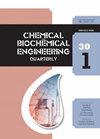用于描述同时传热传质的不同形式的修正因子
IF 0.9
4区 生物学
Q4 BIOTECHNOLOGY & APPLIED MICROBIOLOGY
引用次数: 0
摘要
在文献中,经常提出不同的计算关系来描述在给定设备中发生的相同过程。本文介绍了不同形式的修正因子(阿克曼修正因子)用于描述传热传质同时发生的过程。决定阿克曼修正系数值的方程形式基本上取决于坐标系取向的选择。本文给出了两种形式的方程的推导,通常在此基础上确定该因子的值。最后,本文还包含了描述热量和质量同时传递的方程。这些用于设计各种工业技术(例如,在农业,化学和食品工业中)的各种类型的设备。从这些方程的角度来看,文章主要强调,如果需要使用描述同一过程的几个方程,则应注意确保这些方程相互兼容。在这种情况下,兼容性意味着在将结果从一个方程代入另一个方程时不需要使用符号校正。本文章由计算机程序翻译,如有差异,请以英文原文为准。
Different Forms of the Correction Factor Used to Describe Simultaneous Heat and Mass Transfer
In the literature, different calculation relationships are often presented to describe the same process taking place in the given equipment. This article presents the different forms of the correction factor (Ackermann correction factor) used in describing the pro - cesses in which heat and mass transfer occur simultaneously. The form of the equations determining the value of the Ackermann correction factor basically depends on the choice of the orientation of the coordinate system. The article presents the derivation of two forms of equations, on the basis of which the value of this factor is usually determined. Finally, the article also contains the equations that describe the simultaneous transfer of heat and mass. These are used in the design of various types of equipment that are part of the various industrial technologies (e.g., in agricultural, chemical, and food indus - tries). From the point of view of these equations, the article mainly emphasizes that, if it is necessary to work with several equations describing the same process, care should be taken to ensure that these equations are compatible with each other. In this case, compat - ibility means that there is no need to use a sign correction when substituting the result from one equation into another.
求助全文
通过发布文献求助,成功后即可免费获取论文全文。
去求助
来源期刊
CiteScore
2.70
自引率
6.70%
发文量
23
审稿时长
>12 weeks
期刊介绍:
The journal provides an international forum for presentation of original papers, reviews and discussions on the latest developments in chemical and biochemical engineering. The scope of the journal is wide and no limitation except relevance to chemical and biochemical engineering is required.
The criteria for the acceptance of papers are originality, quality of work and clarity of style. All papers are subject to reviewing by at least two international experts (blind peer review).
The language of the journal is English. Final versions of the manuscripts are subject to metric (SI units and IUPAC recommendations) and English language reviewing.
Editor and Editorial board make the final decision about acceptance of a manuscript.
Page charges are excluded.

 求助内容:
求助内容: 应助结果提醒方式:
应助结果提醒方式:


